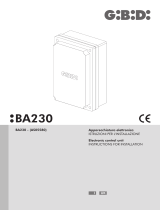
MENU FUNCTION
RADIO
CLR
By selecting this function, the receiver is waiting for (Push) a transmitter code to be erased from
memory.
If the code is valid, it will be stored in memory and OK will be displayed.
If the code is not valid, the Err message will be displayed.
RTR
The memory of the receiver is entirely erased. Confirmation for the operation is asked.
By selecting this function, the receiver waits for (Push) the GPM key to be pressed again to confirm the
operation.
At end of erasing, the OK message is displayed
MENU FUNCTION
RES
RESET of the control unit. ATTENTION!: Returns the control unit to the default values.
Pressing the <PG> button for the first time causes blinking of the letters RES, pressing the <PG> button again
resets the control unit.
NMAN
Displays the number of complete cycles (open+close) carried out by the automation.
When the <PG> button is pressed for the first time, it displays the first 4 figures, the second time it shows the
last 4. Example <PG> 0012 >>> <PG> 3456: made 123.456 cycles.
code
It allows to type in an access protection code to the programming of the control unit.
A four-character alphanumeric code can be typed in by using the numbers from 0 to 9 and the letters
A-B-C-D-E-F.
The default value is 0000 (four zeros) and shows the absence of a protection code.
By replacing the 0000 code with any other code, the protection of the control unit is enabled, thus
preventing the access to any other menu. If a protection code is to be typed in, proceed as follows:
- select the Code menu and press OK.
- the code 0000 is shown, also in the case a protection code has been previously typed in.
- the value of the flashing character can be changed with keys + and -.
- press OK to confirm the flashing character, then confirm the following one.
- after typing in the 4 characters, a confirmation message “CONF” appears.
- after a few seconds, the code 0000 appears again
- the previously stored protection code must be reconfirmed in order to avoid any accidental typing
in.
If the code corresponds to the previous one, a confirmation message “OK” appears.
The control unit automatically exits the programming phase. To gain access to the Menus again, the
stored protection code must be typed in.
While typing in the code, this operation can be cancelled at any moment by pressing keys + and –
simultaneously. Once the password is typed in, it is possible to act on the control unit by entering
and exiting the programming mode for around 10 minutes in order to allow adjustments and tests on
functions.
IMPORTANT: TAKE NOTE of the protection code and KEEP IT IN A SAFE PLACE for future
maintenance operations. To remove the code from a protected control unit, it is sufficient to
reset the code to the 0000 default value.
IF YOU LOOSE THE CODE, PLEASE CONTACT THE AUTHORISED
SERVICE CENTER FOR THE TOTAL RESET OF THE CONTROL UNIT.
TRANSMITTER REMOTE LEARNING
If the transmitter code is already stored in the receiver, the remote radio learning can be carried out (without accessing the control
unit).
IMPORTANT: The procedure should be carried out with gate in the opening phase, during the TCA dwell time.
Proceed as follows:
1 Press the hidden key of the transmitter, the code of which has already been stored in memory.
2 Within 5 seconds, press the already memorised transmitter key corresponding to the channel to be matched to the new transmitter.
The flashing light switches on.
3 Within 10 seconds, press the hidden key of the new transmitter.
4 Within 5 seconds, press the key of the new transmitter to be matched to the channel selected at item 2. The flashing light switches
off.
5 The receiver stores the new transmitter code and exits from the programming mode immediately.
DIAGNOSTICS
In the event of malfunctions, by pressing key + or - the status of all inputs (limit switches,
control and safety) can be displayed. One segment of the display is linked to each input.
In the event of failure it switches on according to the following scheme.
















